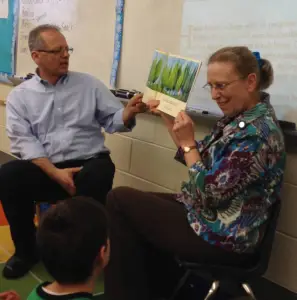7 Tips for Doing Read-Alouds the Right Way
Early in my career, when I taught a self-contained class of fourth- and fifth-grade newcomers, I definitely did read-alouds the wrong way. I knew research showed the benefits of reading aloud to students, especially English learners. I knew reading aloud to students models fluency, builds background knowledge, and increases students’ vocabularies. I also knew reading aloud to students can pique their interest in specific books as well as reading in general.
What I didn’t realize, however, was a classroom practice this beneficial needed to be done purposefully. Far too often, I’d just grab a picture book from a stack of possibilities on my desk—sometimes, I’m ashamed to admit, without even reading it first myself. That’s right—no planning, no follow-up. Not good! I put read-aloud time IN my lesson plans, but I didn’t plan FOR it. You can increase the effectiveness of your read-alouds by planning them carefully and integrating them into the curriculum. Here are some tips I’ve learned for doing read alouds the right way:
1. Use Visuals
With picture books, make sure you hold the book so students can see the pictures as you’re reading. With longer books, you can project the page onto a screen in your classroom. Reading the text and then showing pictures doesn’t count. To be fair, this happens more often with inexperienced guest readers, such as a visiting dignitary or a parent volunteer. Teachers who do effective read-alouds have mastered how to read while holding the book so everybody sees the pages. This photo shows my husband and me as guest readers doing a Turkish-English bilingual read-aloud to a first grade class. It wasn’t perfect, but at least we were making sure everybody could see.
2. Dig Deeper
Read the same picture book several times, but for different purposes: “Yesterday, we talked about how the child felt; today as I read the story, try to think about how the child’s mother felt,” or “Yesterday in this biography, you heard about all of the difficulties the inventor faced. Today as I read it again, think about these difficulties. Which one do you think was the hardest for the inventor to overcome and why?”

Turkish-English bilingual read-aloud
3. Extend Your Read-Aloud Session
For example, read several books in the same genre, by the same author, or on the same theme. Then have students compare and contrast or pick their favorite and explain why.
4. Practice Other Domains
Use your read-aloud time to help students get practice in other domains. After students have listened to a picture book, show the pictures again and have individual students retell the story, page by page. When reading a longer book to older students, have them orally retell the events from the previous chapter as a group or, even better, to each other in pairs. After listening to the day’s story, have students respond to a short writing prompt.
5. Read Aloud to Older Students, Too
It’s not just for young children! You can read aloud a short passage from a longer book or even a picture book to set the stage for a lesson taught to older students. It’s a way to build a shared base of knowledge. Picture books are especially good to use with English learners of all ages because of the visuals. Picture books speak to everyone, but in different ways.
The Giving Tree, for example, is an easy picture book that produces quite different responses from students at different stages in their lives. In this article for general education teachers, I describe how one of my general education colleagues uses picture books with older students to prepare them for their science and social studies lessons. You can do this, too.
6. Remember: Reading Aloud at Home Is Also Important
This topic merits a blog post of its own. For now, though, keep reminding parents of your English learners that reading aloud to their children in their native language and/or English is valuable.
7. Be a Read-Aloud Promoter
Assure your general education colleagues they’re not “giving up” instructional time with read-alouds. Read-aloud time IS instructional time, when it’s well planned and integrated into the lesson. Before, I viewed read-alouds as ways teachers could use up unplanned class time when everything else important had been done. Now I know reading aloud to students is important in its own right. You do, too!
Do you have any other read-aloud tips that have worked well with your English learners? Please share in the comments, below!

About the author
Barbara Gottschalk
Barbara Gottschalk is a veteran educator. She has taught English language learners from first graders to graduate students in five states in three very different parts of the United States plus Japan. Gottschalk has written many successful grants and served as a grant reviewer for TESOL, the National Education Association, and the U.S. Department of Education's Office of English Language Acquisition. She is the author of "Get Money for Your Classroom: Easy Grant Writing Ideas That Work" and "Dispelling Misconceptions About English Language Learners: Research-Based Ways to Improve Instruction."